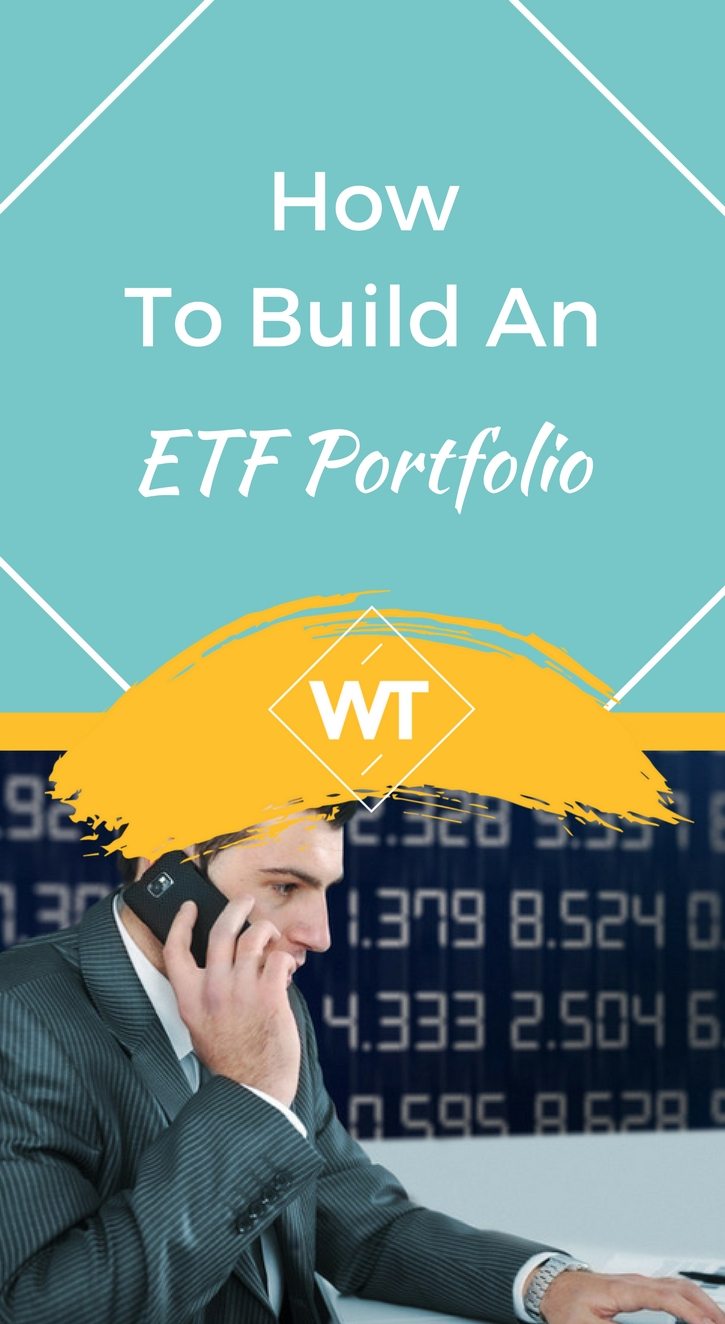How to Build an ETF Portfolio

Let alone the thought of “how to build an ETF portfolio”, just building a normal investment portfolio requires a lot of thought and planning. The reason being, it takes time for a portfolio to take a good shape and provide stable returns.
For smaller investors there is a challenge in terms of saving and accumulating sufficient sums of money that helps them to diversify across asset classes.
On the other hand for large investors the key challenge is the deployment of savings and investments in the right avenues in tune with their requirements and risk appetite.
Until recent times we have heard about building a portfolio using stock selection techniques and using a few debt funds or deposits to get an exposure to debt.
Today, there are many more choices in addition to these traditional instruments. For instance exchange traded funds (ETFs) are going to be an indispensable part of most portfolios. Yes, you can build an ETF portfolio and here is how
What is an ETF? How does it work?
An ETF is a security that tracks and mirrors the performance of an index, commodity, or sector and trades in shares (like a stock) on an exchange. An ETF is actually a sort of mutual fund whose shares or units trade like a stock intraday. The value of an ETF is linked to the value of the asset it is tracking.
For example Nifty ETF is available at Rs.540 when the Nifty index is at a level of 5,440. If Mr.Murali invests in one unit of Nifty ETF (say Nifty Bees which is managed by Benchmark Mutual Fund), he has to shell out Rs.540 to buy one unit.
Buying one unit gives Murali the power to diversify across the Nifty 50 stocks in one shot. If Nifty moves up then Nifty ETF also moves up proportionately because the portfolio of Nifty ETF replicates the Nifty just like an index fund.
In case of individual stock picking you can go wrong in your selection or may not be able to respond to news or developments and your portfolio can lose value. Similarly in case of mutual funds where you invest your savings, the investment calls rest on the Fund Manager who can also be prone to mistakes or errors of judgment. However, if you invest in Nifty ETF your only risk is the fall in index level, but even that is not dramatic because Nifty is diversified across several sectors of the economy and provides good risk control and reasonable returns.
Building a Portfolio
Building an investment portfolio takes time. Even if you have adequate savings and resources it is important to plan and tread cautiously. The following broad steps are required for planning your investments or finances in general: –
- Identify your financial goals
- See what type of investments or options will help you reach your goals
- Monitor and review your steps
Sounds simple? Yes but this is just the overall view of financial planning, while the details can be complex. This is where you need the help of a financial planner/adviser or consultant to help you customize your planning and implementation.
Read more on financial planning at – what is financial planning?
Having ETFs in your Portfolio
Building an ETF portfolio is not so different either. The only difference is instead of spending lot of time, energy and money in researching and picking stocks you just have to invest in one or more ETFs across equity, gold, etc.
The way you look at portfolio management will be different from what you have heard all these days. With the advent of technology, new instruments and choices investors have to break from age old beliefs and explore new choices as shown below:
Old School
Diversify across a number of stocks across sectors to build a portfolio to have more safety and reasonable returns.
Modern Thinking
Diversify across asset classes in order to be protected from the cyclical patterns that exist across various assets or instruments. This was evident when the World Economy went through turbulent phases in 2008 and 2009.
Today the smart investors look at gold, debt, real estate and various other asset classes in addition to equity. Don’t get in to the mental block that stock gurus on television feed you day in and day out saying “equities will always emerge as the best asset class”. This is as stupid as keeping all eggs in one basket.
Old School
Investing in stocks and funds will help me beat the markets or benchmark indices.
Modern Thinking
Forget beating the markets because in majority of the cases many funds and portfolios have failed to even match market returns. So history has proved that index investing provides superior returns than individual stock picking.
John Bogle, the legendary investor and founder of Vanguard Group used to say that if you cannot beat the market its better to go with the market. In other words its wiser to invest in index through index funds or ETFs rather than trying to do your own stock picking.
Modern Thinking here is not really new, but has been hidden from your view. It just needs a little bit of dusting, cleaning and a second look at your investments. These concepts have existed for decades but unfortunately hidden from the view of small or individual investors. Why? Obviously professionals are human beings with vested interests.
They are driven by commissions, fees and other income that they derive by selling investment products or services. So if you care about your hard earned money, its time for you to invest some time and energy to learn the tricks of the trade and do it yourself. If you still need help you can work with an independent financial advisor or write to us at WisdomTimes with your queries or comments.
Components of the Portfolio
Any portfolio will have a variety of instruments and asset classes. Here I am recommending using ETFs as a strategy to minimize your cost, time and efforts involved in operating or managing your investments.
Let me clarify here that we talk about ETFs in this article but your portfolio can contain other investments too – such as fixed deposits, debt fund, real estate, etc. ETFs are not available across all asset classes, so its use will be limited to a few.
The major components of your portfolio should be decided based on your goals, risk appetite, investment horizon, disposable savings and umpteen factors. So here a one size fit all approach does not work.
However, to give you a broad idea the following asset classes are recommended: –
- Equity
- Gold
- Debt
There could be more choices and options within these that can be explored as well.
1. Equity
The investment options through ETFs is not just limited to Nifty ETF (or index ETF). There are a few other options below:
Bank ETF (Example: Bank Bees):
One unit of Bank Bees represents one-tenth of Bank Nifty. For instance when Bank Nifty index is at 10,722 level, Bank Bees trades at Rs.1070. You can also consider Kotak Nifty or QNifty which are ETFs based on Nifty index.
Advantages: You can invest in the banking index as a whole instead of picking banking stocks. If the overall banking sector looks promising, you can invest in the index instead of risking your investment in individual bank stocks.
Nifty Junior ETF (Example: Junior Bees):
One unit of Junior Bees represents one-hundredth of the Nifty Junior Index. For example if Nifty Junior is at 11,149 level, the Junior Bees trades at Rs. 111.
Other Sector based ETFs:
- InfraBees: Tracks CNX Infra Index
- KotakPSUBK: Tracks CNX PSU Bank Index
- M50: CNX Midcap 100
2. Gold
Gold has been one of the most favored asset class in recent times, due the economic uncertainties and financial crisis witnessed in the past 3-4 years. In India Gold has delivered returns of over 20% per annum over the past 3 year period. The best way to invest in gold is obviously through ETFs to be free from hassles of storage, safety, making charges, margins and other costs. There are several Gold ETFs in India such as Gold Bees, Gold Share, KotakGold, QGold, etc. This is a boon for retail investors since they can use the same demat account to invest in stocks as well as Gold.
More reading at – How to invest in gold in India
3. International Equity ETFs
This is at a nascent stage in India, so we need to watch this space for some more time before investing. However, some of the largest investors in the world have used international ETFs to invest in emerging markets as well as developed markets. This provides an opportunity to diversify internationally. Currently there are few international ETF in India. For instance Hang Seng Bees tracks the Hang Seng Index (Hong Kong Stock Exchange’s Index). The ETF is valued based on index after considering currency adjustments.
Motilal Oswal Mutual Fund has launched N100 which tracks the NASDAQ index. One unit of N100 is equivalent to 1/1000th of NASDAQ in Indian Rupees.
Low Cost Diversification Through ETFs:
1. Assume you were able to save Rs.10,000 per month over the past 5 months after all your expenses. You can invest Rs.50,000 buy buying Nifty Bees, Gold Bees as well as Bank Bees. In future you can diversify further by investing in Hang Seng Bees.
2. Doing this without the ETF route would not only be expensive and time consuming but also require a lot of paperwork and running around. In case of gold you also need to worry about finding a bank locker and pay for it too.
Conclusion – Portfolio
As we move in to the future we will have ETFs tracking sectoral indices such as tech index, real estate index, oil and gas index, capital goods index and so on.
Similarly in commodities space we could see indices on silver, platinum, copper, etc. Exchange traded funds have truly revolutionized the markets enabling investors to invest across asset classes in a single platform.
An ETF is not going to replace all the asset classes or instruments, but will definitely be a smart investment vehicle for individual investors – ranging from small investors to rich individuals.
If you have not started investing in ETFs its time you start doing some research on Nifty ETF and Gold ETF which are the simplest of all to start with. I’d be happy to hear your feedback, queries or comments on this topic. Hope this has been a good primer on how to build an ETF portfolio.









Leave a Reply